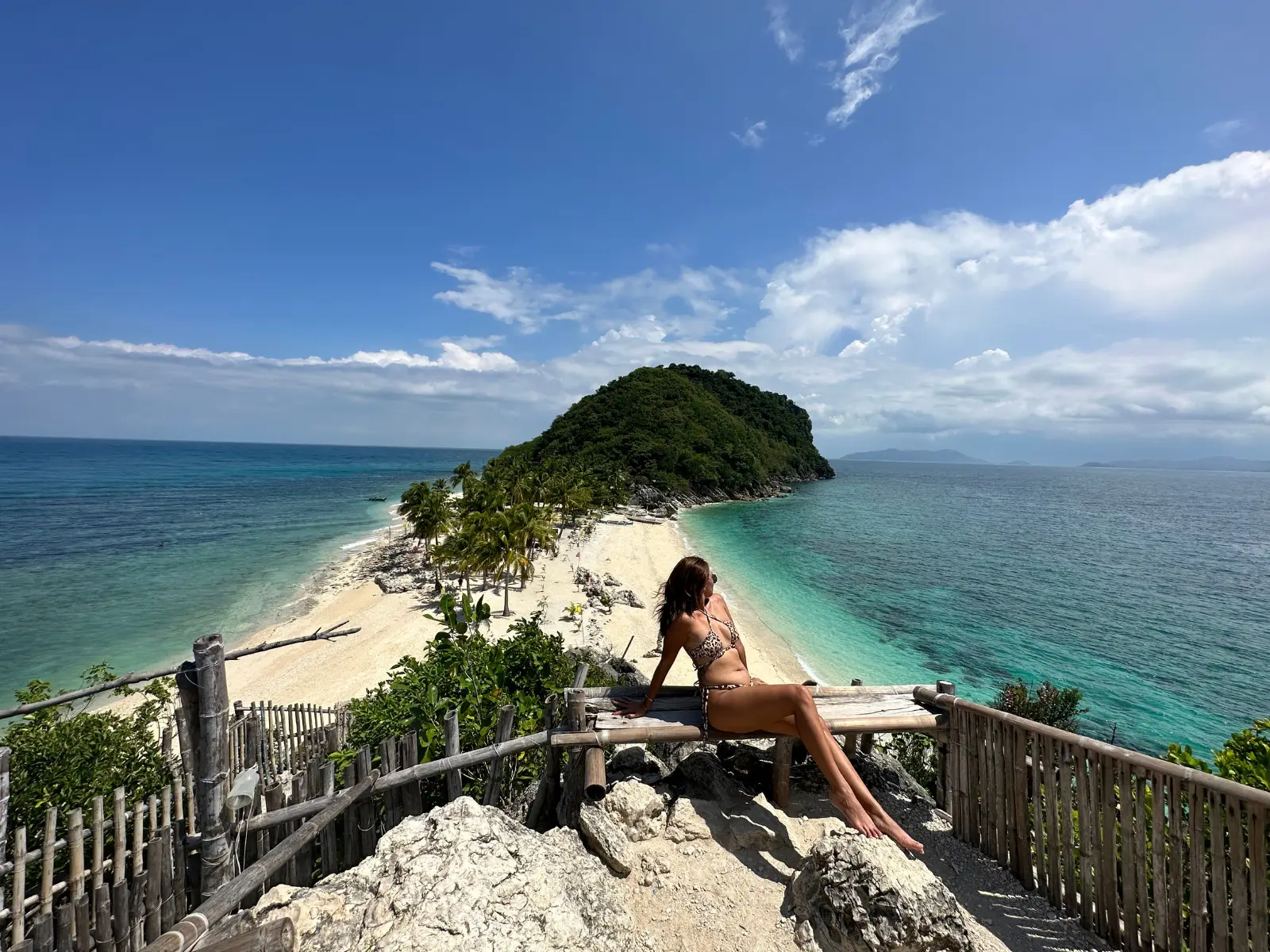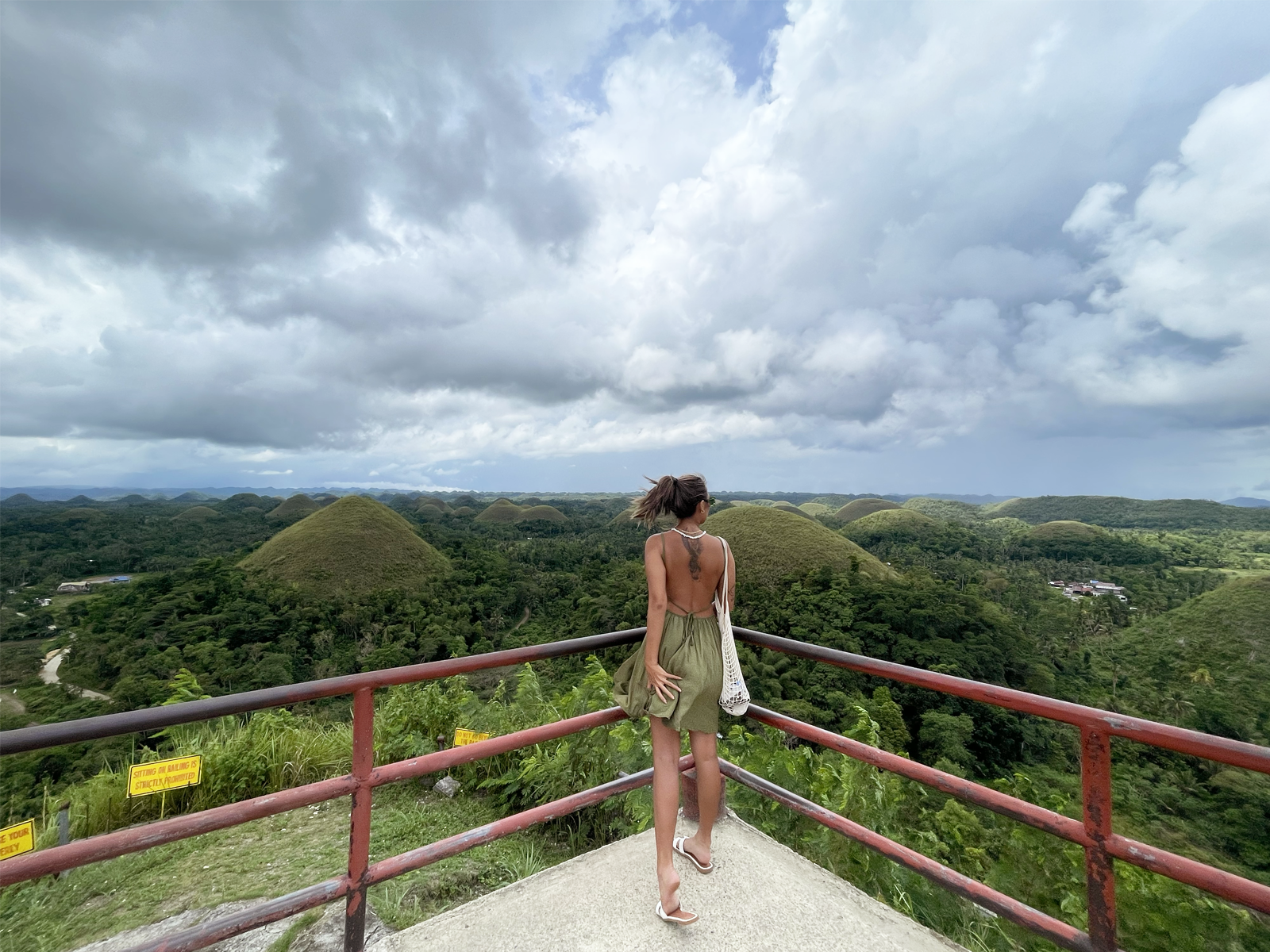SIQUIJOR ISLAND TRAVEL GUIDE: Top Destinations and Best Things To Do
Witchcrafts, black magic, and mystical traditions — these are some of the notions when you hear about Siquijor Island.
But seeing beyond these conceptions and beliefs, whatever they may be, Siquijor Island is indeed mystical! The island is a free and easy living island, a long stretch of white sand beaches, majestic waterfalls, a heavenly spot for divers, has great food, and super friendly locals.
Since I started solo traveling, it’s one of my favorite islands in the Philippines, along with Panglao Island, Siquijor Island, and Coron Island, to name a few. Here’s why!
BEST & TOP DESTINATIONS IN SIQUIJOR ISLAND
Siquijor Island being in small size can still be toured within a day. The early you arrive in the island, the better so you can explore Siquijor’s top tourist attractions by motorcycle and spend half a day lounging by the beach.
CAMBUGAHAY FALLS - Best Tourist Attraction in Siquijor
This stunning three-level waterfall is one of Siquijor’s top tourist destinations.

In just around 100 steps, you will hike down the stairs to reach the waterfall. Cambugahay Falls usually gets the most tourists that’s why I highly suggest to go there as early as 7:00 in the morning so you can take photos in a less-crowded waterfall. There are two swings in the bottom tier of Cambugahay Falls and you can swing in an unlimited amount of time.
Cambugahay Falls Fees & Tips
- Entrance Fee: FREE! (Yes, really!)
- Parking: About ₱20-₱30 for my scooter.
- Rope Swing: Voluntary tip for the local guides who help you (I gave ₱50).
- Getting There: Easy to find on Google Maps, just follow the paved road then a short walk down stone steps.
- Wear: Swimsuit, obviously! And water shoes might be handy for the slippery rocks.
PALITON BEACH - Best Beach in Siquijor Island
The glistening fine white sand and the coconut trees on the shoreline of San Juan make Paliton Beach the best and most rated beach of Siquijor Island.
If you needed some chill time, head to Paliton Beach. People call this “Siquijor’s Little Boracay,” and I can totally see why. It’s a beautiful stretch of white sand with clear, shallow turquoise water, framed by coconut trees. It’s much quieter than Boracay, though, which is perfect.
Paliton Beach Fees & Tips
- Entrance Fee: FREE!
- Parking: Around ₱20-₱30 for the scooter.
- What to Do: Swim, sunbathe, read a book, and definitely stay for the sunset!
- Amenities: There are usually a few small local stalls selling snacks and drinks.
- Best Time: Late afternoon for the best light and sunset views.
- Go there early and get lucky to arrive with fewer people, then you’d get the best photo of the swing.
SALAGDOONG BEACH - Most Famous Cliff Jumping Point in Siquijor
If you’re in search of adrenaline and have an adventurous heart like me, then you will fall in love with Salagdoong Beach. It is located on the eastern side of Siquijor — around 30-minutes drive from Cambugahay Falls and an hour from Paliton Beach.
Salagdoong Beach has two beautiful cove-like beaches with lovely clear water. But the real draw is the cliff diving platforms. There are two platforms—one about 7 meters high and another about 10 meters high—that let you jump straight into the stunning turquoise ocean. I went for the 10-meter one, and the rush was incredible! It’s a really well-maintained resort area, so it feels very safe and organized.
Salagdoong Beach Fees & Tips
- Entrance Fee: Around ₱30-₱50 per person.
- Parking: Around ₱20-₱30 for a scooter.
- Cliff Jump Fee: Usually included in the entrance, but sometimes there’s a small extra fee (₱10-₱20) if you want to jump multiple times.
- Amenities: Cottages for rent, restaurant, restrooms.
- What to Bring: Swimsuit, towel, sunscreen, and your brave face for the jumps!
- Best Time: Mid-morning or early afternoon for good light and less crowding for the jumps.
RELATED ARTICLE: Read the Dive Guide of Freediving in Siquijor
PITOGO CLIFF -- A Hidden Cliff Paradise You Shouldn't Miss
Pitogo Cliff isn’t as well-known as Salagdoong, but it’s amazing. It’s a natural cliff face that drops into super clear, deep blue water. There aren’t official platforms, so it feels more rugged and local. We found a few spots to jump from, and the feeling of freefalling into that cool water was incredible. Not for the faint of heart, but if you love a thrill, this is it!
Pitogo Cliff Fees & Tips
- Entrance Fee: ₱30 per person.
- Parking: Just parked my scooter on the side of the road, no fee.
- Safety: Be super careful! Check water depth before jumping and only jump if you’re confident. It’s not developed like other jump spots.
- What to Bring: Water, sun protection, and maybe a local friend who knows the safe spots!
Old Enchanted Balete Tree
The Century Old Balete Tree (also known as the Enchanted Balete Tree) is one of Siquijor Island’s most iconic spots. This giant, ancient tree is absolutely massive, with roots that stretch and intertwine like something out of a fairy tale. What’s unique is the natural spring that flows from its base into a fish pond where you can get a “fish spa”—little fish nibble on your feet! It’s a really cool, eerie, and strangely relaxing experience.
Enchanted Balete Tree Fees & Tips
- Entrance Fee: ₱30 per person.
- Fish Spa: Included with the entrance fee, stay as long as you like!
- Souvenirs: Local vendors sell Siquijor products like love potions (for fun!) and herbal medicines.
- Myth: It’s believed to be home to supernatural beings. You can definitely feel a unique energy here.
Laga-an Falls
If you want an uncrowded waterfall, visit Lagaan Falls in Lazi. This off-the-beaten-path jungle waterfall in Siquijor is just a 30-minute drive from San Juan. It is packed with adventures, such as rope swings, rock jumps, swimming holes, and a small cave that you can swim through if you’re extra adventurous.
Although there is a clear trail, I recommend taking a local guide with you to take you down to the falls for your safety and good company while walking in a 15-minute dirt trail underneath a dense forest. Locals in Siquijor are very nice people! Just give your guide a good tip after.
Laga-an Falls Fees & Tips
- Entrance Fee: ₱50 per person.
- Parking: ₱10 for scooter parking.
- Guide: A local guide might offer to take you for a small fee/tip, especially if the path isn’t clear. Worth it if you’re unsure.
- Wear: Sturdy sandals or water shoes for the trek.
"Welcome to Siquijor" Sign -- Church of St. Francis of Assisi
After docking at the Siquijor port, the first landmark you see is the beautiful old Church of St. Francis of Assisi. Right next to the church is the huge, colorful “Welcome to Siquijor” sign. You have to stop here for the classic island arrival photo. It’s the perfect way to announce you’ve officially begun your adventure! The church itself is a beautiful, simple stone structure that gives you a glimpse into the island’s deep, religious history.
Lazi Church (San Isidro Labrador Parish Church)
Lazi Church, or San Isidro Labrador Parish Church, is a huge, old stone church, really well-preserved, and it just stands out majestically in the town of Lazi. It was built way back in the late 1800s during the Spanish colonial era, and you can really feel the history radiating from its stone walls. It’s a National Cultural Treasure for a reason!
Lazi Church Fees & Tips
- Entrance Fee: FREE (It’s a functioning church).
San Isidro Labrador Convent
Right across from Lazi Church is the San Isidro Labrador Convent, and it’s just as impressive. This is actually the largest and one of the oldest convents in Asia! Stepping inside feels like going back in time. It’s made of coral stones and hardwood, and you can explore its old halls and rooms. It really shows you what life was like hundreds of years ago here.
San Isidro Labrador Convent Fees & Tips
- Entrance Fee: Usually around ₱20-₱30 for maintenance.
- What to Do: Walk through the museum-like rooms, see the old artifacts, and appreciate the scale of the building.
- Photography: Allowed inside, but be mindful of any signage.
WHERE TO STAY IN SIQUIJOR ISLAND
It’s best to book an accommodation in San Juan, Siquijor. That’s the heart of the island. It will be easy for you to wander around, look for places to eat, experience its nightlife, and more. Here are my personal recommendations:
TRAVEL TIPS IN SIQUIJOR ISLAND
Before I leave you to plan your own trip, here are the essential notes and practical things I learned while zipping around Siquijor. Knowing these things makes your visit much easier!
Getting Around: The Motorbike is King
Forget about taxis or complicated public transport; the easiest and most fun way to see the island is by renting your own scooter (or motorbike).
- Renting: You can find rental shops right near the Siquijor port or sometimes your accommodation will offer rentals.
- Cost: Standard rentals are usually ₱350 to ₱500 per day, depending on the bike type and how long you rent it for. I paid ₱400 per day for mine.
- Gas: Gas stations are sparse. Most of the time, you’ll buy gasoline from roadside stalls (usually old soda bottles filled with gas) for about ₱60–₱70 per liter. Fill up whenever you see a station!
- License: They usually don’t ask for an international license, but always carry your valid driver’s license just in case.
- Safety: The roads are generally good but watch out for stray dogs, chickens, and bumps. Always wear a helmet!
Money Matters: ATMs and Cash
Siquijor runs mostly on cash, especially the small local stalls and tricycle drivers.
- ATMs: Don’t rely on ATMs being everywhere. The most reliable ATMs are located in the larger towns like Siquijor Town (near the port) and Larena. I recommend pulling out enough cash in Cebu or Dumaguete before you ferry over, just to be safe.
- Fees: Expect standard local bank withdrawal fees.
Tipping Guide: Tipping isn’t strictly necessary or mandatory, but it is always appreciated for great service!
- Restaurants: If paying with cash, you can leave the change or about 5–10% of the bill.
- Guides/Drivers: For guides who help you at the falls or a tricycle driver who was helpful and friendly, a tip of ₱50–₱100 is generous.
Staying Connected: Wi-Fi and Signal
Compared to bigger cities, the internet here can be… challenging. It’s a great excuse to unplug!
- Wi-Fi: Wi-Fi is available in most guesthouses and resorts, but the speeds can be slow, especially in the evenings. Don’t plan on streaming movies or doing heavy work.
- Mobile Signal: I found Globe and Smart signals to be decent, but it can be spotty, especially when you head into the mountains or to the more remote beaches.
Local Etiquette and Safety
Siquijor is known as the “Island of Fire,” and while it has a mystical reputation, the locals are incredibly friendly and welcoming.
- Be Polite: A simple “Salamat” (Thank you) goes a long way. Locals are relaxed and helpful.
- Respect the Myths: Even if you don’t believe in the healing or magic stories, be respectful of the local traditions and beliefs. Don’t mock or joke about them in front of locals.
- Water Safety: When cliff jumping (at Salagdoong or Pitogo), always check the tide and water depth with a local first. Tides change, and what was safe this morning might not be safe this afternoon.
What to Pack
- Sun Protection: Sunscreen, hat, and sunglasses (the sun is intense!).
- Water Bottle: Stay hydrated on those long motorbike rides.
- Power Bank: To keep your phone charged for photos and navigation.
- Cash: As mentioned, lots of cash!
How To Get To Siquijor Island
Siquijor Island is accessible only by ferry, which is part of the fun! No airport means the island remains beautifully quiet. To get there, you must book a flight to a nearby major hub first.
Fly to a Hub There are no direct flights to Siquijor Island. You must fly into one of these major airports, which serve as the main jump-off points:
- Cebu (CEB): The busiest hub with the most flight options.
- Dumaguete (DGT): The nearest airport, offering the fastest ferry route.
- Bohol (TAG/Panglao): A scenic, but longer, ferry route.
- From Cebu to Siquijor via Tagbilaran (Oceanjet) – Departing from Cebu Port (Pier Uno) at 1:00 pm via Tagbilaran. It’s a 5-hour trip with a 20-minute stopover in the port of Tagbilaran, Bohol. One-way ticket costs around PHP 1,600 in a tourist-class accommodation.
- From South Cebu, like Moalboal or Oslob to Siquijor – Arrive at the port of Lilo-an. There is a direct ferry from Cebu to Siquijor via Liloan Port. Maayo Shipping departs once a day at 10:00 am. The ride costs PHP 200 per person and takes 2.5 hours. No need to book in advance, just pay directly there.”
- From Cebu to Siquijor Via Dumaguete – There are shipping lines, like Cokaliong, that departs every Monday, Wednesday, Thursday, and Saturday at 8:00PM from Cebu Port. Travel time is around 6-7 hours so you will arrive in Dumaguete at around 2:00 AM the next day. On Sundays, the boat leaves at 12:00 NN and arrives at Dumaguete by 6:00 PM. Make sure to check the website for available trips.
- From Dumaguete to Siquijor – Multiple daily trips from Dumaguete to Siquijor via Ocean Jet, Montenegro Lines, GL Shipping Lines, and Aleson Shipping. The first trip is as early as 5:00 AM, and travel time usually takes around 3 hours for PHP 150. I recommend Ocean Jet.
Khae Santiago
Thanks for reading! ❤ I'm a solo female traveler, freediver, and coffee enthusiast sharing raw, inspiring stories from the road. I hope my adventures help spark yours! :>>









Pingback: 3 Best Dive Spots In Negros Oriental: Bacong Port, Dauin, And Apo Island | MISSKHAE